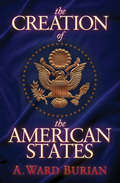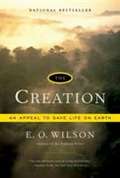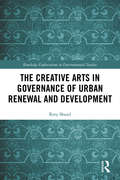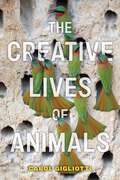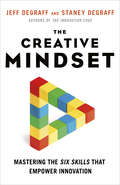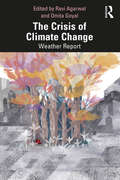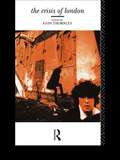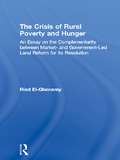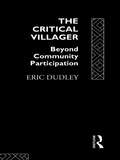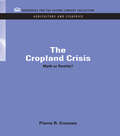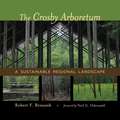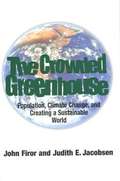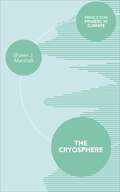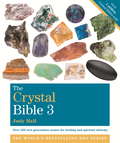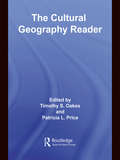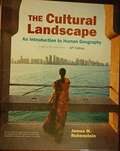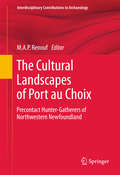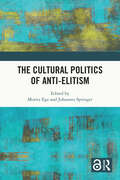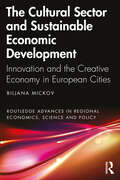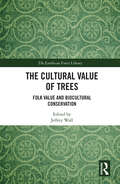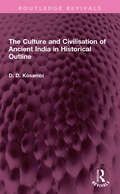- Table View
- List View
The Cow with Ear Tag #1389
by Kathryn GillespieTo translate the journey from a living cow to a glass of milk into tangible terms, Kathryn Gillespie set out to follow the moments in the life cycles of individual animals—animals like the cow with ear tag #1389. She explores how the seemingly benign practice of raising animals for milk is just one link in a chain that affects livestock across the agricultural spectrum. Gillespie takes readers to farms, auction yards, slaughterhouses, and even rendering plants to show how living cows become food. The result is an empathetic look at cows and our relationship with them, one that makes both their lives and their suffering real.
The Cranefly Orchid Murders (A Martha's Vineyard/Victoria Trumbull Mystery #2)
by Cynthia RiggsNinety-two-year-old Martha's Vineyard native Victoria Trumbull knows more about the island, its people, and its history than anyone else living. So when Phoebe Eldridge sells her family land to a developer, the Conservation Trust enlists Victoria to search the land for an endangered plant, since the state prohibits bulldozing rare-plant habitats. Delighted to add another purpose to her daily walks, Victoria sets out with an eleven-year-old assistant and the "endangered" list in hand. Her first find, though, is the body of the developer's rather dubious attorney. Victoria is a most unusual amateur detecctive at her advanced age. Join her as she spins out factual information about this beautiful New England island which she has accumulated in her 92 years living there. She uses a cane, must rest often, suffers from a sore toe which won't fit in her shoes, and confidently deals with residents and tourists of all ages combining knowledge from the past and present to solve crimes. Look for the rest of the books in the cozy Victoria Trumbull/Martha's Vineyard mystery series in the Bookshare collection including #1 Deadly Nightshade, #3 The Cemetery Yew, #4 Jack in the Pulpit, #5 The Paperwhite Narcissus and 7 more.
The Creation of the American States
by A. Ward BurianThe fascinating story of how and why all fifty American states were formed—and how they became a part of history&’s greatest social experiment. Every US state has a unique history that deserves a separate book. The Creation of the American States provides readers with essential information on how each of the fifty states came into being. From the time of the first explorers and settlers to the present day, A. Ward Burian tells the story of how the America was established over the course of four hundred years. He examines what motivated brave souls to venture into an unknown wilderness and then delves into the time frame for each state&’s discovery, settlement, and consolidation into the United States. With brief biographies interjected that spark human interest and provide perspective to what was taking place, The Creation of the American States shares a better understanding of how the North American continent was transformed from a wilderness into a powerful nation—state by state.
The Creation: An Appeal to Save Life on Earth
by Edward O. WilsonIn this daring work, Edward O. Wilson proposes an alliance between science and religion to save Earth's vanishing biodiversity.
The Creative Arts in Governance of Urban Renewal and Development (Routledge Explorations in Environmental Studies)
by Rory ShandThis book focuses on the role of the creative sector in the governance of urban renewal and economic development initiatives. Rory Shand examines the ways in which both the top-down nature of the creative sector, and the bottom-up roles of creative arts organisations, drive development and engage with local communities or areas in regeneration projects that target employment, training and education, as well as social engagement. Underpinning these projects are governance mechanisms, through delivery, funding and participation. Drawing on case studies from the UK, Germany and Canada, Shand compares national creative sector policies and creative arts bodies engaged in the governance of urban renewal and development programmes, as well as including a comparative chapter offering an overview of best and worst practice, which also examines and summarises the key themes across both theory and practice. In his concluding remarks, he highlights and discusses the key challenges posed by governance mechanisms to urban renewal and economic development programmes and identifies future comparative case studies in the field. This book will be of great interest to students of environmental studies, public policy and politics and geography, as well as being a relevant resource for practitioners from NGOs, local and national levels of governments and community projects.
The Creative Lives of Animals (Animals in Context)
by Carol GigliottiWinner of the 2023 Nautilus Book Award in the category of Animals & NatureThe surprising, fascinating, and remarkable ways that animals use creativity to thrive in their habitatsMost of us view animals through a very narrow lens, seeing only bits and pieces of beings that seem mostly peripheral to our lives. However, whether animals are building a shelter, seducing a mate, or inventing a new game, animals’ creative choices affect their social, cultural, and environmental worlds.The Creative Lives of Animals offers readers intimate glimpses of creativity in the lives of animals, from elephants to alligators to ants. Drawing on a growing body of scientific research, Carol Gigliotti unpacks examples of creativity demonstrated by animals through the lens of the creative process, an important component of creative behavior, and offers new thinking on animal intelligence, emotion, and self-awareness. With examples of the elaborate dams built by beavers or the lavishly decorated bowers of bowerbirds, Gigliotti provides a new perspective on animals as agents in their own lives, as valuable contributors to their world and ours, and as guides in understanding how creativity may contribute to conserving the natural world. Presenting a powerful argument for the importance of recognizing animals as individuals and as creators of a healthy, biodiverse world, this book offers insights into both the established and emerging questions about the creativity of animals.
The Creative Mindset: Mastering the Six Skills That Empower Innovation
by Jeff DeGraff Staney DeGraff&“Jeff and Staney emphasize that small acts of creativity can have huge consequences and that ordinary people can do extraordinary things if they can see the opportunities in front of them.&”—Mitch Jacobson, Executive Director, Austin Technology Incubator, UT Blackstone LaunchPad, University of Texas at AustinNearly all of today's major innovation workshops and programs call on organizations to drive innovation. What they miss is that innovation comes from the personal creativity of individuals. And creativity doesn't require an advanced education or technical skills—all employees can be creative. Often, all they lack is a fitting mindset and the right skills. The Creative Mindset brings how-to advice, tools, and techniques from two master innovators who have taught and worked with over half of all Fortune 500 companies. Jeff and Staney DeGraff introduce six essential creative-thinking skills that can be easily mastered with limited practice and remembered as the acronym CREATE: Concentrate, Replicate, Elaborate, Associate, Translate, and Evaluate. These six skills, sequenced as steps, simplify and summarize the most important research on creative thinking and draw on over thirty years of real-world application in some of the most innovative organizations in the world. It's time to rethink the way we make innovation happen. Individual creativity is an immense untapped resource, and you don't have to be Beethoven to make a big difference. As the spirit of chef Gusteau proclaims in the Pixar classic Ratatouille, &“Anyone can cook.&”
The Crisis of Climate Change: Weather Report
by Ravi Agarwal Omita GoyalThis volume outlines the specific conditions and responses to climate change in India. It discusses various aspects of the planetary crisis that have acquired widespread global urgency: global warming induced by anthropogenic emissions, largely owing to the fossil fuel-based economic growth model; severe environmental decline; and the catastrophic consequences that threaten the very foundations of modern life, which has been based on using nature as a ‘resource’ instead of as an ecosystem in which human life exists. The book brings together contributors with expertise in fi elds as varied as national security, public policy, environmental law, climate justice activism, anthropology, restoration ecology, conservation biology, wildlife ecology, the health sector and medicine, conservation science and sustainability, gender, humanities and the creative arts. It includes a new spectrum of responses—holistic or alternate, literary and the arts, dance and poetry—and their interface with climate change, which are often left out in science and policy circles, and an unusual ground-up approach with grassroots movements’ perspectives along with theoretical practices and a Gandhian way of thinking in a global economy. Comprehensive, accessible and topical, this book will be useful to scholars and researchers of environmental and sustainability studies, natural resources, environment and technology, sociology of development, development studies, public policy, energy and environment and urbanisation. It will also interest practitioners, policymakers, think tanks and NGOs working on climate change issues.
The Crisis of Global Modernity
by Prasenjit DuaraIn this major new study, Prasenjit Duara expands his influential theoretical framework to present circulatory, transnational histories as an alternative to nationalist history. Duara argues that the present day is defined by the intersection of three global changes: the rise of non-western powers, the crisis of environmental sustainability and the loss of authoritative sources of what he terms transcendence - the ideals, principles and ethics once found in religions or political ideologies. The physical salvation of the world is becoming - and must become - the transcendent goal of our times, but this goal must transcend national sovereignty if it is to succeed. Duara suggests that a viable foundation for sustainability might be found in the traditions of Asia, which offer different ways of understanding the relationship between the personal, ecological and universal. These traditions must be understood through the ways they have circulated and converged with contemporary developments.
The Crisis of London
by Andy ThornleyLondon is in a mess. This is evident from the increasingly unpleasant experience of daily life in the capital, from homelessness and unemployment to frustrating transport facilities and the general bad quality of the environment. However it is not only citizens of London who are suffering but the business community as well. London is having to face increasing competition from other European cities. There is growing appreciation and debate about these problems from companies, political parties, local government and community organisations. The Crisis of London provides a solid analysis of what has gone wrong and explores policy directions that could make the city a more humane and livable place. Beginning with a discussion of the basic elements of a home, a job and a means of travelling around, it becomes clear that even in these essential aspects London is failing. A feature of the crisis is an increasingly divided city with conditions for the poorer citizens worsening all the time. The authors consider the quality of the environment. They examine the greening of the city and the need for sustainability, the privatisation and dehumanisation of public spaces; the fear experienced by women, denying them full access to the capital; the position of ethnic minorities, and the perspectives of local communities. Using the case studies of Docklands and Kings Cross, the author's raise the crucial question of the government of the capital. This review of the city concludes with an analysis of a potential vision for London involving both the creation of the necessary institutional structures and also the will to address the needs of all the capital's citizens. The authors argue that a strategic approach is needed which accepts that the market alone cannot solve the problem. Stronger public intervention and government action is necessary if London is to match the developments in other European cities.
The Crisis of Rural Poverty and Hunger: An Essay on the Complementarity between Market- and Government-Led Land Reform for its Resolution (Routledge Studies In Development Economics Ser.)
by M. Riad El-GhonemyM. Riad El-Ghonemy argues that if current trends in government-led and market based land reforms persist the rural poor population in developing countries will continue to rise.Based on nearly half a century of academic and field research this valuable work presents compelling evidence on persistent rural poverty, hunger and increased inequality in
The Critical Villager: Beyond Community Participation
by Eric DudleyWhen aid to the Third World actually works it is usually on such a small scale that it makes little impact on the world's problems. Can demands for generalizable actions be reconciled with location-specific solutions? The Critical Villager considers how community-based technical aid can be made more effective and sustainable. Calling for development workers, policy makers and researchers to put themselves in the place of the intended beneficiaries of aid, it suggests concrete principles for action and research. It argues that participatory research and 'transfer of technology' should not be regarded as rival models for development but rather as complementary components in a single process of effective aid.
The Cropland Crisis: Myth or Reality? (RFF Agriculture and Fisheries Set)
by Pierre CrossonThis book examines the factors affecting the demand for agricultural land in the United States and the costs of meeting increasing demand. Originally published in 1982
The Crosby Arboretum: A Sustainable Regional Landscape (Reading the American Landscape)
by Robert F. Brzuszek Neil G. OdenwaldSince its genesis in 1980, Crosby Arboretum in southern Mississippi has attracted international recognition for its contributions to architecture, biology, and landscape design. Now owned and operated by Mississippi State University, Crosby is the first fully realized ecologically designed arboretum in the United States and the premier native plant conservatory in the Southeast.Former site director and curator Robert F. Brzuszek provides a detailed survey of the arboretum's origins, planning, construction, and ongoing management. More than just a botanical center, Crosby emerged as one of the first American landscape projects to successfully balance natural habitat and planned design. The book's generous selection of photographs and drawings illustrate the beauty and purpose of the site's components: the award-winning Pinecote Pavilion, designed by architect Fay Jones; a 104-acre focus area that includes the Piney Woods Lake, which displays native water plants in their natural setting; and seven hundred additional acres of savanna, woodland, and aquatic environments that nurture more than 300 species of indigenous trees, shrubs, wildflowers, and grasses. Utilizing the interactions between two opposing natural forces -- fire and water -- Crosby Arboretum protects the biological diversity indigenous to the Pearl River Drainage Basin, in southern Mississippi and southeastern Louisiana. Brzuszek's inspiring and informative account will help further Crosby's role as a model of sustainable landscape design and management across the country.
The Crowded Greenhouse: Population, Climate Change, and Creating a Sustainable World
by John Firor Judith JacobsenWhat is the best way to move our planet to a safe and sustainable future? This book focuses on two global issues - rapid population growth and a human-induced climate change caused by emissions - that lie at the heart of this problem. John Firor and Judith Jacobsen summarize the current status of these two issues, show how they are related to one another, and prescribe steps that governments, economies, societies, and individuals can adopt to ensure their stability." --BOOK JACKET. Title Summary field provided by Blackwell North America, Inc. All Rights Reserved
The Cryosphere (Princeton Primers in Climate #4)
by Shawn J. MarshallThe cryosphere encompasses the Earth's snow and ice masses. It is a critical part of our planet's climate system, one that is especially at risk from climate change and global warming. The Cryosphere provides an essential introduction to the subject, written by one of the world's leading experts in Earth-system science. In this primer, glaciologist Shawn Marshall introduces readers to the cryosphere and the broader role it plays in our global climate system. After giving a concise overview, he fully explains each component of the cryosphere and how it works--seasonal snow, permafrost, river and lake ice, sea ice, glaciers, ice sheets, and ice shelves. Marshall describes how snow and ice interact with our atmosphere and oceans and how they influence climate, sea level, and ocean circulation. He looks at the cryosphere's role in past ice ages and considers the changing cryosphere's future impact on our landscape, oceans, and climate. Accessible and authoritative, this primer also features a glossary of key terms, suggestions for further reading, explanations of equations, and a discussion of open research questions in the field.
The Crystal Bible, Volume 3 (Godsfield Bibles Ser.)
by Judy HallFeatured in Kindred Spiritmagazine, this third volumeof the best-selling Crystal Bible books presents more than 250 new generation, high-vibration stones for healing and transformation. Included are many new and rare minerals whose esoteric properties are not described elsewhere. This essential guide also includes a section on crystal skulls, crystal beings, Madagascan stones, and how to work with the 'new' chakras, such as the Soul Star and Manifestation chakras, that are stimulated by the powerful crystals featured. Your Crystal Bible Volume 3 includes... Crystal Reference Crystal Innovations Crystal Beings Crystal Structure High Vibration Crystals Exploring Crystal Potential Crystal Skulls Building in Stone The Madagascar Stones Crystal Directory Awakening Crystals Physical and Subtle Anatomy Chakras Associations The 'New Chakras Healing Grids Making a Gem Essence ...And Much More!
The Crystal Bible, Volume 3: Godsfield Bibles
by Judy HallFeatured in Kindred Spiritmagazine, this third volumeof the best-selling Crystal Bible books presents more than 250 new generation, high-vibration stones for healing and transformation.Included are many new and rare minerals whose esoteric properties are not described elsewhere.This essential guide also includes a section on crystal skulls, crystal beings, Madagascan stones, and how to work with the 'new' chakras, such as the Soul Star and Manifestation chakras, that are stimulated by the powerful crystals featured.Your Crystal Bible Volume 3 includes...Crystal ReferenceCrystal InnovationsCrystal BeingsCrystal StructureHigh Vibration CrystalsExploring Crystal PotentialCrystal SkullsBuilding in StoneThe Madagascar StonesCrystal DirectoryAwakening CrystalsPhysical and Subtle AnatomyChakras AssociationsThe 'New ChakrasHealing GridsMaking a Gem Essence...And Much More!
The Cultural Geography Reader
by Patricia L. Price Timothy OakesThe Cultural Geography Reader draws together fifty-two classic and contemporary abridged readings that represent the scope of the discipline and its key concepts. Readings have been selected based on their originality, accessibility and empirical focus, allowing students to grasp the conceptual and theoretical tools of cultural geography through the grounded research of leading scholars in the field. Each of the eight sections begins with an introduction that discusses the key concepts, its history and relation to cultural geography and connections to other disciplines and practices. Six to seven abridged book chapters and journal articles, each with their own focused introductions, are also included in each section. The readability, broad scope, and coverage of both classic and contemporary pieces from the US and UK makes The Cultural Geography Reader relevant and accessible for a broad audience of undergraduate students and graduate students alike. It bridges the different national traditions in the US and UK, as well as introducing the span of classic and contemporary cultural geography. In doing so, it provides the instructor and student with a versatile yet enduring benchmark text.
The Cultural Landscape: An Introduction To Human Geography
by James M. RubensteinThe Cultural Landscape: An Introduction to Human Geography AP Edition
The Cultural Landscapes of Port au Choix
by M. A. RenoufNewfoundland lies at the intersection of arctic and more temperate regions and, commensurate with this geography, populations of two Amerindian and two Paleoeskimo cultural traditions occupied Port au Choix, in northern Newfoundland, Canada, for centuries and millennia. Over the past two decades The Port au Choix Archaeology Project has sought a comparative understanding of how these different cultures, each with their particular origin and historical trajectory, adapted to the changing physical and social environments, impacted their physical surroundings, and created cultural landscapes. This volume brings together the research of Renouf, her colleagues and her students who together employ multiple perspectives and methods to provide a detailed reconstruction and understanding of the long-term history of Port au Choix. Although geographically focussed on a northern coastal area, this volume has wider implications for understanding archaeological landscapes, human-environment interactions and hunter-gatherer societies.
The Cultural Politics of Anti-Elitism
by Moritz Ege Johannes SpringerThis book examines the highly ambivalent implications and effects of anti-elitism. It draws on this theme as a cross-cutting entry point to provide transdisciplinary analysis of current conjunctures and their contradictions, drawing on examples from popular culture and media, politics, fashion, labour and spatial arrangements. Using the toolboxes of media and discourse analysis, hegemony theory, ethnography, critical social psychology and cultural studies more broadly, the book surveys and theorizes the forms, the implications and the ambiguities and limits of anti-elitist formations in different parts of the world. Anti-elitist sentiments colour the contemporary political conjuncture as much as they shape pop cultural and media trends. Populists, right-wing authoritarian ones and others, direct their anger at cultural, political and, sometimes, economic elites while supporting other elites and creating new ones. At the same time, "elitist" knowledge and expertise, decision-making power and taste regimes are being questioned in societal transformations that are discussed much more positively under headlines such as participation or democratization. The book brings together a group of international, interdisciplinary case studies in order to better understand the ways in which the battle cry "against the elites" shapes current conjunctures and possible future politics, focusing on themes such as nationalist political discourse in India, Austria, the UK and Hungary, labour struggles and anti-oligarchy rhetoric in Russia, tax-avoiding elites and fiscal imaginaries, working-class agency, Melania Trump as a celebrity narrative in Slovenia, aesthetic codes of the Alt-Right, football hooliganism in Germany, "hipster hate" in German political discourse or the politics of expertise and anti-elite iconography in high fashion internationally. The book is intended for undergraduates, postgraduates and postdoctoral researchers.
The Cultural Sector and Sustainable Economic Development: Innovation and the Creative Economy in European Cities (Routledge Advances in Regional Economics, Science and Policy)
by Biljana MickovThe cultural sector plays an important role in sustainable economic development and creates economic activities, opportunities for entrepreneurship and jobs, adding to the attractiveness of cities and contributing to the development of tourism. The Cultural Sector and Sustainable Economic Development: Innovation and the Creative Economy in European Cities offers both a theoretical and practical analysis of the contemporary approach to culture and innovation, with special emphasis on the relationships among culture, innovation and the economy. Sustainable development, itself, balances environmental protection, culture, social progress, the economy and stability today and for the future. The book’s key theme is the role and possibility of culture as a laboratory, with a strong supporting subtext on innovative practice. The text provides an eclectic mix of possibilities that reinforce and underscore the full innovative and complex potentials of culture. It is a cross-disciplinary volume presenting case studies that cover the main theme of cultural ecosystem in a very broad sense, highlighting the relationships that could lead to a sustainable system where economy and culture are the main players. It proposes and maps the European perspective of urban cultural development and suggests that the successes and challenges of European cities under consideration may offer guidance on best practices for urban development in other distant cultural contexts. This book is written in such a way that it can be used as a summary for a cultural professional, a reference text for an academic or for actors in local development and cultural policy at European, national and local levels.
The Cultural Value of Trees: Folk Value and Biocultural Conservation (The Earthscan Forest Library)
by Jeffrey WallThis volume focuses on the tree, as a cultural and biological form, and examines the concept of folk value and its implications for biocultural conservation. Folk value refers to the value of the more-than-human living world to cultural cohesion and survival, as opposed to individual well-being. This field of value, comprising cosmological, aesthetic, eco-erotic, sentimental, mnemonic value and much more, serves as powerful motivation for the local performance of environmental care. The motivation to maintain and conserve ecology for the purpose of cultural survival will be the central focus of this book, as the conditions of the Anthropocene urgently require the identification, understanding and support of enduring, self-perpetuating biocultural associations. The geographical scope is broad with chapters discussing different tree species from the Americas and the Caribbean, East Asia, Eurasia and Australia and Africa. By focusing on the tree, one of the most reliably cross-culturally-valued and cross-culturally-recognized biological forms, and one which invariably defines expansive landscapes, this work illuminates how folk value binds the survival of more-than-human life forms with the survival of specific peoples in the era of biocultural loss, the Anthropocene. As such, this collection of cross-cultural cases of tree folk value represents a low hanging fruit for the larger project of exploring the power of cultural value of the more-than-human living world. This book will be of great interest to students and scholars of conservation, biodiversity, biocultural studies and environmental anthropology.
The Culture and Civilisation of Ancient India in HIstorical Outline (Routledge Revivals)
by D D KosambiFirst published in 1965, The Culture and Civilisation of Ancient India in Historical Outline is a strikingly original work, the first real cultural history of India. The main features of the Indian character are traced back into remote antiquity as the natural outgrowth of historical process. Did the change from food gathering and the pastoral life to agriculture make new religions necessary? Why did the Indian cities vanish with hardly a trace and leave no memory? Who were the Aryans – if any? Why should Buddhism, Jainism, and so many other sects of the same type come into being at one time and in the same region? How could Buddhism spread over so large a part of Asia while dying out completely in the land of its origin? What caused the rise and collapse of the Magadhan empire; was the Gupta empire fundamentally different from its great predecessor, or just one more ‘oriental despotism’? These are some of the many questions handled with great insight, yet in the simplest terms, in this stimulating work. This book will be of interest to students of history, sociology, archaeology, anthropology, cultural studies, South Asian studies and ethnic studies.


